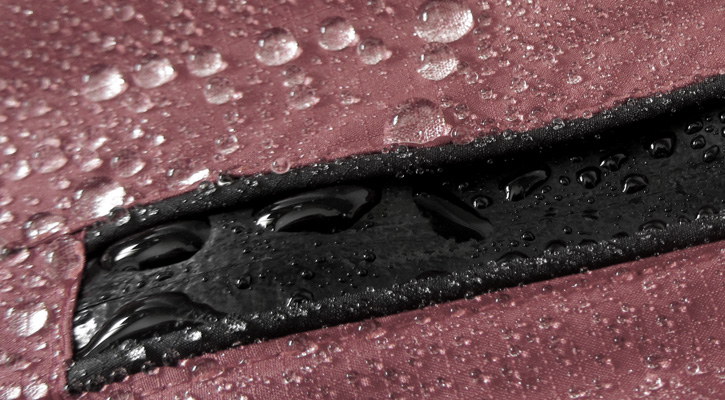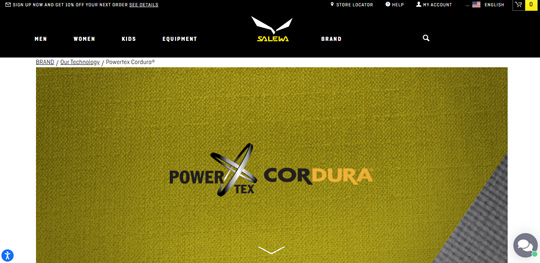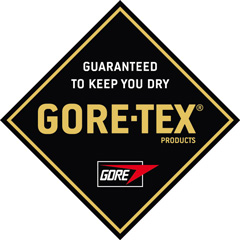
When it’s time to gear up for an outdoor adventure, the fabric of your clothing can be the difference between enjoyment and discomfort.
Two famous materials in the world of technical fabrics are Powertex and Gore-Tex.
These materials are at the forefront of outdoor gear technology, promising to keep you dry and comfortable, whether you’re caught in a downpour or scaling a mountain.
While they share some common ground in waterproof and breathable capabilities, Powertex and Gore-Tex each bring unique benefits to your jackets and outdoor clothing.
Today, we’ll explore what sets these fabric technologies apart, examining their individual features and how they stand up against the elements.
By the end of this comparison, you’ll have a clearer idea when choosing the right material for your next outdoor excursion.
Let’s begin!
1. Powertex Cordura by SALEWA

SALEWA Powertex Cordura: image salewa.com
SALEWA has crafted its patented Powertex fabric to be exceptionally sturdy, making it perfectly suited for the rigorous demands of off-piste skiing and alpine ski touring.
This triple-layered laminate material provides a shield against harsh weather, boasting impressive durability, steadfast waterproof qualities, and superior breathability.
It incorporates an ultra-thin polyurethane (PU) membrane that actively transports moisture vapor to the exterior, while the inclusion of CORDURA® nylon enhances the fabric’s ability to withstand wear and tear.
Also, the eco-conscious, water-repellent finish that is free from PFCs helps to repel water, aiding the membrane’s performance.
This is for the Powertex 3L variant. There exists a Powertex 2L version as well, which consists of two layers and offers a different set of attributes and lower performance.
Powertex 3L Features
- Robust waterproof capabilities ensure protection against rain and snowfall.
- Enhanced durability through resistance to wear and tear.
- High breathability to maintain comfort during active sports.
- A thin polyurethane (PU) layer that aids in the wicking away of perspiration.
- Composition of the outer fabric: Predominantly 94% nylon (polyamide) CORDURA® for abrasion resistance, complemented by 6% stretchable elastane to enhance movement and flexibility.
- Environmentally friendly, PFC-free coating that repels water, bolstering the effectiveness of the membrane.
- Performance metrics for Powertex 3L nylon: waterproof rating (Water column) of 20,000 mm; breathability of 20,000 g/m2/24h.
- Ideal for activities such as skiing, snowboarding, hiking, and alpine climbing.
2. Gore-Tex

Gore-Tex® Logo: image gore-tex.com
Developed in the 1970s, Gore-Tex® has evolved with additional options building upon the foundational technology.
Constructed from ePTFE (expanded PolyTetraFluoroEthylene), the Gore-Tex membrane boasts a microporous structure that is notably durable. It excels in shielding against bad weather and exhibits minimal water adsorption.
This fine membrane, which contains more than 9 billion tiny pores for every square inch (approximately 1.4 billion pores per square centimeter), is sandwiched between the exterior fabric and the inner lining in various forms, tailored to specific Gore-Tex versions.
The main features of Gore-Tex technology are its capacity for waterproofing, windproofing, and breathability, sustaining these qualities over an extended period and surpassing the norms for windproof performance. The membrane’s breathability is exceptional, allowing internal moisture to escape, helping to regulate body heat.
Additional features in certain Gore-Tex products, like jackets, include the application of a DWR (Durable Water Repellent) treatment to the outermost fabric. This enhances the material’s ability to repel water, further increasing its resistance to moisture.
Learn more:
What is Gore-Tex and How Does It Work?
Why is Gore-Tex so Expensive? Is It Worth It?
Gore-Tex Features
- Crafted from ePTFE, this membrane is characterized by its microscopic porous nature and exceptional durability, boasting billions of pores.
- It is designed to be impermeable to water, permeable to air, resistant to wind, and notably long-lasting.
- The technology is available in a range of options like Paclite, Active, Pro, and Shakedry, each tailored for distinct types of outdoor sports and activities.
- Certain versions of Gore-Tex are enhanced with a DWR (Durable Water Repellent) layer to improve the fabric’s ability to repel water.
- In terms of performance, it boasts a waterproof rating (water column) exceeding 28,000 mm and a breathability score surpassing 15,000 g/m2/24h.
- This material is ideal for activities such as hiking, skiing, snowboarding, alpine climbing, and biking.
3. Differences and Comparison
Here are the differences between Gore-Tex and Powertex 3L:
Material:
Powertex 3L consists of CORDURA® nylon blended with stretchy elastane, whereas Gore-Tex utilizes ePTFE (expanded PolyTetraFluoroEthylene), recognized for its tiny, yet robust pores.
Construction:
Powertex 3L features a triple-layered laminate construction. In contrast, Gore-Tex comprises a membrane that is laminated to the outer material and the inner lining, with specific configurations varying by product.
Performance:
The waterproof rating (water column) for Powertex 3L stands at 20,000 mm, alongside a breathability factor of 20,000 g/m2/24h. Gore-Tex has a waterproof measure of over 28,000 mm and breathability exceeding 15,000 g/m2/24h.
Water-Repellent Treatments:
Powertex employs an eco-conscious, PFC-free water-repellent finish, whereas select Gore-Tex garments are treated with a DWR (Durable Water Repellent) coating to heighten their resistance to moisture.
Resistance to Wear:
Powertex boasts enhanced durability and resistance to abrasion, thanks to its CORDURA® nylon composition. Gore-Tex maintains a reputation for long-lasting durability, attributable to its ePTFE construction.
Use:
Powertex is commonly found in winter sports apparel such as ski and snowboard gear. Gore-Tex, thanks to its broader global presence, is used across a wide range of outdoor activities beyond winter sports.
Read next:
Gore-Tex® vs DryVent™: Which is Better?
Sympatex vs Gore-Tex®: Which is Better?
